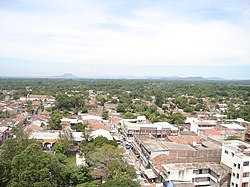La Paz Department (El Salvador)
| La Paz | ||
|---|---|---|
| Department | ||
 |
||
|
||
 Location within El Salvador |
||
| Coordinates: 13°29′02″N 88°57′32″W / 13.484°N 88.959°WCoordinates: 13°29′02″N 88°57′32″W / 13.484°N 88.959°W | ||
| Country |
|
|
| Created (given current status) |
February 1852 | |
| Seat | Zacatecoluca | |
| Area | ||
| • Total | 1,227.6 km2 (474.0 sq mi) | |
| Area rank | Ranked 9th | |
| Population | ||
| • Total | 328,221 | |
| • Rank | Ranked 10th | |
| • Density | 270/km2 (690/sq mi) | |
| Time zone | CST (UTC−6) | |
| ISO 3166 code | SV-PA | |
La Paz is a department of El Salvador in the south central area of the country. The capital is Zacatecoluca. La Paz has an area of 1,228 km² and a population of more than 328,000. The department was created in 1852. There are various caves containing rock writing. The department has a church in Zacatecoluca where the Independence Hero Dr Jose Simeon Cañas y Villacorta was born. He was known as "The Liberator of the Slaves in Central America". In 1833, Anastasio Aquino, an indigenous person, proclaimed himself as "The Emperor of the Nonualcos".
Cañas was born in Zacatecoluca on February 18, 1767. His parents were Don Pablo Cañas and Dona Ana Lucia Villacorta de Cañas. He studied in the school San Francisco de Borja and later on in San Carlos University, in Guatemala, where he was a rector, philosopher, theologist and humanist. On December 31, 1823, he became the first advocate for the first abolition of slavery in the Americas, decades before the abolitionist movement in the United States.
He was born in the town of Santiago Nonualco on April 15, 1792. His parents were Tomás Aquino and María de San Carlos, natives and residents of the place. In 1833, during the presidency of Mariano Prado, reformations were imposed that caused dissatisfaction, including a personal tax that was interpreted as a restoration of the tribute, one of the most unjust colonial taxes of the time. It was Santiago de Nonaluco that a rebellion began under the leadership of Aquino.
Minero was born in Zacatecoluca on May 11, 1917. He began painting at a young age. He showed his works in Guatemala, Honduras, Colombia, Venezuela, United States, and Germany. He was professor of the School of plastic arts of the University of El Salvador (UES). From 1964 up to 1972, he was the Dean of the Department of Journalism at UES.
He was born in Zacatecoluca on August 16, 1889 and died in San Salvador in 1980. Some of his works are the “National Readings of El Salvador”, “This is my earth”, “Schools and teachers from El Salvador”, “Mother earth”, and “Seed”.
This department is one of the oldest in the country; hence it adopted many of ancestral customs and dances including “The Tiger and the Deer”, "The Ascension Bulls”, “The Levers of Santa Cruz”, and others.
The dance of The Tiger and the Deer goes back to 1868, when San Juan Nonualco was inhabited by natives that lived off the hunting of deer that were plentiful in the area. However, there was a tiger that devoured the animals. The dance presents the story of a married couple that left to hunt the tiger; however, he was attacked by the animal and he had to request aid to some timber men that were close and to beg to the Señor de la Caridad, protector of the municipality, to save them of the danger. The hunters killed the tiger. The dance is carried out in the party of May 2. It consists of four characters: “the old ones” that represent the couple that go with the shotgun and the bow; the tiger and the Lord of the drum that mark the steps of the dance. The spectators watch when the tiger attacks the old ones, but these behead it. The most amusing part is the “repartition” of the portions of the animal, which is called “behead the priest”, “the forehead for Vicente”, “the head for Teresa”... until all the residents are beheaded.
...
Wikipedia

